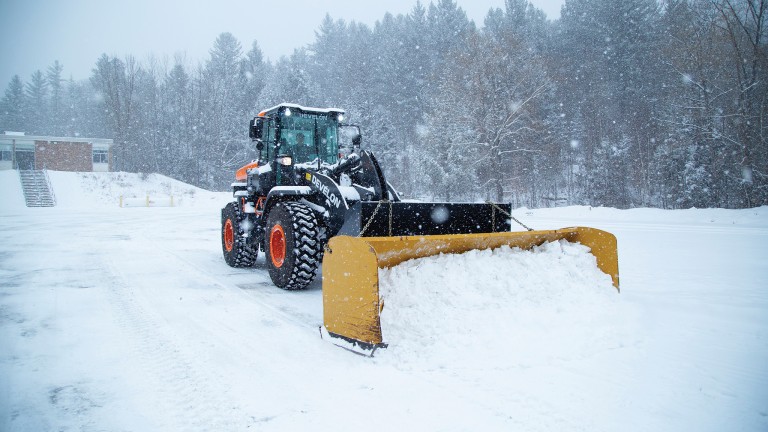The manual will explain which machine components should be regularly inspected.
DEVELON
3. Use a winter fuel grade
Switching to a special winter fuel grade, such as No. 1 and No. 2 diesel or a winterized blend, can help you prepare for colder temperatures.
“No. 1 grade diesel fuel has lower energy components than its counterpart, No. 2 grade, because paraffin [a type of wax] has been removed from the chemical mix,” Sherman says. “The absence of this chemical allows it to remain in liquid form during winter. The downside of No. 2 diesel is its tendency to transform into a thickened gel when the temperature drops. This can often lead to hard starts and other complications during winter.”
Winterized fuel is a combination of No. 1 and No. 2 fuels. When blended, they hold a higher concentration of No. 1 grade fuel and are used when it becomes too cold, starting at 14 degrees Fahrenheit (-10 degree Celsius). The combination of both grades should contain enough energy components and lubricant properties to reduce the chance of the chemical mix gelling in colder temperatures.
“Investing in quality fuel blended appropriately for the climate and season may give you better peace of mind, lower your consumption, provide fewer filter changes, and deliver long component life,” Sherman says. “Also, verify the quality of fuel you are getting from your provider, checking to make sure water and other contaminants are not present in your fuel.”
4. Inspect diesel exhaust fluid and adjust the coolant
Diesel exhaust fluid (DEF) is another component that is susceptible to variations in hot and cold temperatures. In very cold temperatures, DEF can freeze, so make sure you keep DEF in storage during the winter months.
“Purity and concentration are critical with DEF,” Sherman says. “Work with a local dealer to better understand how to store and handle DEF.”
Also, inspect the coolant to make sure it’s free of impurities as you run the engine. If the coolant needs to be replaced, choose the best grade for your machine and region. For your machine to perform well in colder weather, the antifreeze mix must be properly blended.
5. Check the tires and batteries
Winter maintenance also means checking the tires. Undetected leaks or improper inflation can lead to premature wear and potentially tire failure over time.
“Over-inflated tires reduce surface contact, generally reducing traction,” Sherman says. “However, under-inflated tires can result in losing the bead seat and thus create downtime. Therefore, daily checks of tire pressure and tire condition is a good practice.”
Using L3 radial tires may be best during winter because they have deeper treads and provide good traction in snowy conditions. Inflating tires with nitrogen gas can be a good alternative to help maintain proper tire pressure.
Before cold weather hits, inspect the wheel loader’s battery and charge it if needed. There is always a draw on the battery, so unless the battery has been maintained or disconnected while stored, it will slowly run down and will need to be charged before use.
Batteries should always be fully charged in cold weather. A trickle charger can be connected to help build the voltage at a lower rate, which can improve battery life. It’s a good idea to inspect and clean the battery connections. Corroded terminals can cause hard starting and charging issues. You can also use a battery blanket to help keep the battery warm when your machine is not in use.
6. Inspect lights and safety features
Verify that all lights, including headlights and taillights, are functioning accordingly. Replace any burnt-out bulbs to ensure that your operators have the appropriate lighting when working in low light or at night. If you’re frequently working at night, consider installing additional lighting on your wheel loader. You can purchase work lights to give yourself extra visibility and make yourself more visible to other machines and vehicles.
“A rotating beacon or flasher is a wise investment to increase operator safety,” Sherman says. “Check local requirements to make sure your wheel loader is properly equipped for clearing snow.”
Additionally, inspect advanced safety features such as proximity sensors (object detection), camera systems, and blind spot monitoring, before operating during winter. DEVELON recommends inspecting the Transparent Bucket feature on its machines as well.
Around view monitor (AVM) camera systems are becoming increasingly popular in wheel loaders. These systems use cameras mounted on the machine to provide as much as 270 degrees of visibility to the surrounding area, giving your operators better situational awareness. Some monitoring systems include features such as object detection and warning systems, which sound an alert if there are any potential hazards in the machine’s path.
Don’t forget to check the cab door and window seals for leaks or cracks, install a new windshield wiper blade, and add low-temperature washer fluid.
Read the full article here

